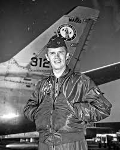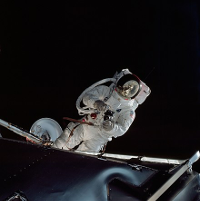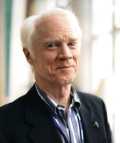Rusty Schweickart is an engineer, fighter pilot, scientist, and astronaut who is perhaps most well-known for being part of an Apollo lunar mission. Schweickart was born on Oct. 25, 1935, in Neptune Township, N.J. Growing up on a farm, he knew that he wanted to fly. He graduated from Manasquan High School in 1952 and went to the Massachusetts Institute of Technology (MIT), from which he received a bachelor's degree in aeronautical engineering in 1956 and a master's degree in aeronautics and astronautics in 1963. 
In between getting his two degrees, he served in the Air Force and his state Air National Guard, logging more than 4,000 hours of flying time. Also during his master's degree studies, he was a research scientist at MIT. Schweickart was named to NASA Astronaut Group 3 in October 1963. His original assignment was part of the backup crew for Apollo 1, along with Jim McDivitt and Dave Scott. It was this same crew that flew into low Earth orbit aboard Apollo 9 in March 1969. The mission was a full-throttle test of most of the systems that would be needed to land on the Moon. The crew spent 10 days in low Earth orbit, performing all manner of tests: of docking and undocking maneuvers, of the engines of the lunar module, of navigation systems, of backpack life support systems. They even threw in a spacewalk, with Schweickart notching 37 minutes of extravehicular activity (EVA). 
One of the tests was for one of the crew to climb from one spacecraft to the other. In the all-important rehearsals for the worst case scenario, scientists wanted to be confident that the astronauts could do such a thing if the command module and lunar module wouldn't come together while orbiting the Moon. Schweikart was ill again on the day of the EVA, and so his spacewalk was more of a space-stand and missed out the test of the Portable Life Support System backpack. Schweikart transitioned out of the Apollo program and into that of Skylab, a space station prototype. He was backup commander for Skylab 2 and a member of the support crew for Skylab 4. He then moved into a role in Washington, D.C., that was more of a liaison role with the outside world, before serving in California state government. Then-Gov. Jerry Brown appointed Schweikart as his assistant for science and technology and then as a member of the California Energy Commission. In the late 1990s, he was President and Chief Executive Officer of ALOHA Networks, a wireless Internet equipment company. 
His private sector experience also included stints at a communications satellite company. Continuing work he began in the 1980s, he founded the B612 Foundation, a non-profit formed to help investigate methods of defending Earth from asteroid threats. |
|
Social Studies for Kids
copyright 2002–2026
David White




